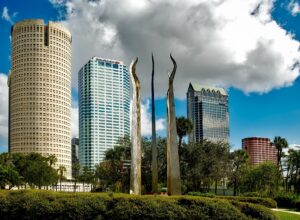The 8 Pros and Cons of Living in Tampa, Florida – 2024 Latest Update
Tampa, Florida is nestled along Florida’s picturesque Gulf Coast and has emerged as a vibrant city, affectionately called the “Sunshine City.”
Its thriving cultural scene, robust economic opportunities, and access to breathtaking beaches has propelled Tampa to the top of many peoples’ minds as a top destination for those looking for a perfect blend of leisurely living and promising prospects.
In fact, we ranked Tampa as not just one of the best cities on the Gulf Coast part of the state, but in the whole state altogether.
We examine the actual pros and cons of living in Tampa in-depth in this post so that you can decide if moving there is the best option for you.

Table of Contents
Top 4 Pros of Living in Tampa
1. Paradise of Beaches and Sun
Residents and visitors alike enjoy Tampa’s alluring climate nearly year-round. With an average of over 240 sunny days per year according to the National Weather Service, Tampa emerges as a true oasis for those seeking endless blue skies.
The abundance of sunshine sets the stage for a whole host of recreational opportunities, with Tampa’s pristine beaches taking center stage. Whether it’s strolling along the powdery shores, engaging in water sports, or simply unwinding with a book under a palm tree, the beach is a nearby escape for Tampa residents.
Two world-famous beaches, Clearwater Beach and St. Pete Beach, are just a stone’s throw away and features sugary sands and sparkling blue waters.
The consistent sunshine also invites exploration beyond the beaches. Tampa’s numerous parks and outdoor spaces come alive under the warm rays, including the scenic Riverwalk to the expansive Curtis Hixon Waterfront Park.
2. Flourishing Job Market
Tampa’s recent popularity is propelled by its thriving economy that offers endless opportunities. A wide-range of companies, ranging from finance and healthcare to technology and tourism, have established their headquarters in and around Tampa.
Big companies such as Raymond James Financial, BayCare Health System, and the University of South Florida contribute to the city’s flourishing job market.
Additionally, Tampa has become a hotbed for innovation and entrepreneurship, attracting ambitious startups.
3. Affordability and Quality of Life
Compared to other major cities in Florida, Tampa offers a more affordable cost of living. Housing, utilities, and everyday expenses are generally within reach for residents with a normal job.
As James, a recent new resident, explains, “I was pleasantly surprised by how affordable it is to live here. It’s almost half as cheap as when I was living in New York.”
Tampa’s overall lower cost of living allows residents to enjoy a comfortable lifestyle while maintaining financial stability.
Of course, the fact that Florida doesn’t levy a state income tax on their residents also helps Tampanian keep a bit more of their money as well.
4. Rich Cultural Scene
One of the best parts about Tampa is the number of things to do throughout the year. Tampa embraces its cultural diversity through a vibrant arts scene, lively festivals, and engaging events.
For example, the city features world-class museums, like the Tampa Museum of Art and the Florida Museum of Photographic Arts.
Jennifer, an art enthusiast who has been living in Tampa for the past 6 years, remarks, “Tampa’s art scene is incredible. There’s always something new to discover and experience.”
Additionally, sports fans can watch one of the three professional sports teams that call Tampa home. The Tampa Bay Buccaneers, Rays, and Lightning are all exciting franchises that have their home stadium in and around the city.
4 Cons of Living in Tampa
1. Heat and Humidity Challenges
Tampa’s warm climate comes with extremely high humidity, particularly during the summer months. Local resident Carlos admits, “The humidity can take some getting used to. Summers can be quite intense if you have never lived in the Deep South.”
Coping with the heat and humidity may require adjustments to your daily routines, including more indoor activities and planning outdoor excursions during the cooler times of the day.
2. Potential Impact of Hurricanes
Tampa’s location along the Gulf Coast exposes it to the risk of hurricanes and tropical storms. While the city has robust disaster preparedness measures in place, the annual hurricane season can be a source of concern for residents.
As it moved over Tampa in 2017, Hurricane Irma left a lasting mark on the city and resulted in extensive power outages, flooding, and property damage.
In 2020, Tropical Storm Eta also made landfall close to Tampa Bay, bringing with it significant rains and localized flooding.
These events highlight the importance of preparedness and vigilance when residing in Tampa, particularly during hurricane season.
3. Traffic Congestion and Infrastructure Shortcomings
As a growing city, Tampa experiences increased traffic congestion, especially during rush hour. Ongoing construction projects can further impact travel times.
Local Tampa resident Sarah shares her perspective, saying, “Traffic can be frustrating, especially during peak hours. I’ve learned to plan my commute accordingly and explore alternative routes.”
Another source of traffic is from seasonal visitors known as “snowbirds.” These visitors from northern states flock to Tampa during the winter months, causing further increases in traffic congestion on the roads.
4. Limited Public Transportation Options
While Tampa is working to enhance its public transportation system, current options are limited for some residents. Reliance on personal cars remains prevalent, which can be inconvenient for those who prefer or rely on public transit or who cannot afford a car.
However, there are new efforts to expand the public transportation networks and improve connectivity, providing hope for future improvements.
Summary – Pros and Cons of Living in Tampa, Florida
Tampa, Florida is truly a city of opportunities. Its year-round sunshine, diverse economy, relative affordability, and cultural richness make it an enticing destination.
However, challenges like heat and humidity, hurricanes, traffic congestion, and limited public transportation should be taken into account.
As you contemplate your next move, consider the experiences and insights of Tampa’s residents as well. By weighing these pros and cons, you can navigate the path towards a well-informed decision, determining whether Tampa aligns with your aspirations and lifestyle.
Research Methodology
We used a multifaceted research strategy to present an accurate and thorough review of the benefits and drawbacks of residing in Tampa, Florida. The methods listed below was used to compile pertinent data and insights:
Data Analysis:
The collected data, including qualitative responses from interviews and surveys as well as quantitative data from official sources, were carefully analyzed to identify recurring themes, sentiments, and patterns. This process involved coding and categorizing the data to draw meaningful conclusions and present a balanced view of the pros and cons of living in Tampa.
Local Interviews:
Interviews were conducted with a diverse group of Tampa residents to gather their perspectives on living in the city. These interviews provided valuable insights into the pros and cons from individuals with firsthand experience. Their opinions and anecdotes have been included throughout the blog post to add authenticity and local flavor.
While every attempt has been taken to assure the accuracy and dependability of the information provided, it is vital to remember that everyone’s experiences and perspectives are unique. To give readers a thorough insight of life in Tampa, Florida, the research approach used tried to gather a representative spectrum of viewpoints.





